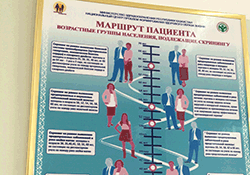Addressing inequities through responsive health services in Kazakhstan

WHO
Significant investments in health infrastructure, human resources and targeted health interventions in recent years in the Mangystau region of Kazakhstan have increased life expectancy at birth by about 4 years since 2007, led to a decrease since 2008 in the infant mortality rate from 21.2 to 9.49 per 1 000 live births and decreased the maternal mortality rate from 79.5 to 11.0 per 100 000 live births.
Despite such progress, inequities remain a public health concern. Moreover, the region still registers comparatively high mortality due to cardiovascular diseases (85.2 per 100 000 population in 2013), ischemic heart disease and stroke (51.5 and 36.0 per 100 000 among males and females, standardized rate), incidence of tuberculosis is high and associated with multidrug resistance (3.7 per 100 000 population in 2013).
In this context, the Government of Kazakhstan approached WHO and other United Nations agencies to support the development of regional policies that are responsive to the population’s needs, with a primary health care approach that includes intersectoral actions.
In response, a multidisciplinary WHO team visited Mangystau on 10-17 December 2014 and, jointly with the local counterparts, developed an action plan based on a rapid assessment of health needs. Following field visits and interviews with Mangystau health authorities, it was agreed that strategies for prompt actions will consist of:
- engaging patients in their health care plans to increase compliance;
- empowering providers to deliver high-quality interventions;
- enabling health facility managers to plan strategically; and
- enabling policy-makers to undertake evidence-based actions at population level.
It is expected that, by December 2016, this agreement will contribute significantly to preventing premature death due to heart attack and strokes, among other outcomes, while effectively managing hypertension and diabetes at primary care level and noncommunicable disease prevention at population level.



